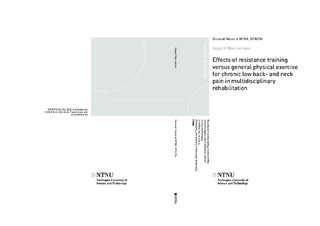| dc.contributor.advisor | Fimland, Marius Steiro | |
| dc.contributor.advisor | Vasseljen, Ottar | |
| dc.contributor.advisor | Mork, Paul Jarle | |
| dc.contributor.author | Iversen, Vegard Moe | |
| dc.date.accessioned | 2018-09-24T10:31:03Z | |
| dc.date.available | 2018-09-24T10:31:03Z | |
| dc.date.issued | 2018 | |
| dc.identifier.isbn | 978-82-326-3223-7 | |
| dc.identifier.issn | 1503-8181 | |
| dc.identifier.uri | http://hdl.handle.net/11250/2564064 | |
| dc.description.abstract | This thesis is based on the recognition of chronic low back pain and chronic neck pain as being major contributors to disability and suffering worldwide. There is no known cure for chronic neck pain and low back pain, but it is possible to alleviate their symptoms through different management strategies. Individuals with chronic neck or low back pain that comprises a substantial psychosocial impact and who have responded poorly to treatment in usual care often have their pain managed by multidisciplinary rehabilitation in order to target multiple aspects of their symptoms. It is possible that multidisciplinary rehabilitation can be improved by replacing the general physical exercise component of the treatment programme with progressive resistance training. Progressive resistance training refers to a systematic form of strength training that aims to enhance muscular strength, and some studies have suggested that progressive resistance training can be effective in alleviating the symptoms of chronic low back pain and especially chronic neck pain.
The specific aim of the research for this thesis was to investigate whether replacing general physical exercise with progressive resistance training could improve the effects of multidisciplinary rehabilitation. Accordingly, two randomized controlled trials with similar designs were carried out to investigate the effects of replacing general physical activity with progressive resistance training for patients with chronic low back pain (the low back pain study) and patients with chronic neck pain (the neck pain study). Elastic resistance bands were used to provide external resistance in the progressive resistance training exercises in both studies. Additionally, a crossover study was carried out to compare the muscular activation levels, in which surface electromyography (sEMG) with elastic resistance bands(ERB) was compared with training with conventional resistance training equipment (CRE) (the EMG study).
Participants in the low back pain and the neck pain study were randomized to three weeks of multidisciplinary rehabilitation with either general physical exercise or progressive resistance training, and were then instructed to continue with their respective home-based programmes for a further nine weeks. The primary outcome in both studies was pain-related disability. In the EMG study, the muscle activity of relevant muscles was assessed while participants performed squats, stiff-legged deadlifts, unilateral rows, and lateral pulldowns using ERB and CRE.
There were 74 participants in the low back pain study, 59 in the neck pain study, and29 in the EMG study, but loss to follow-up at 12 weeks resulted in 46 participants in the lowback and 31 participants the neck pain study at the 12-week endpoint.
The most important findings of the research presented in this thesis was that replacing generalphysical exercise with progressive resistance training using lastic resistance bands did notresult in reduced pain-related disability for patients with chronic low back pain or chronicneck pain in multidisciplinary rehabilitation. It is unlikely that a lower dropout rate and/or more participants would have altered this main conclusion, since the changes in the main outcome in the groups were almost identical. Thus, clinicians should recommend either of these forms of exercise depending upon the patient’s interests and motivation. Lastly, elastic resistance bands were found to be a viable option to conventional resistance training equipment for the exercises unilateral rows and lateral pulldowns, since they induced fairly similar muscle activity during those exercises. Elastic resistance bands induced lower muscle activity for some important muscles during stiff-legged deadlifts and squats compared with CRE, but muscle activity was fairly similar between the modalities for the extensor muscles in the back and hip. | nb_NO |
| dc.language.iso | eng | nb_NO |
| dc.publisher | NTNU | nb_NO |
| dc.relation.ispartofseries | Doctoral theses at NTNU;2018:216 | |
| dc.relation.haspart | Paper 1:
Iversen, Vegard Moe; Vasseljen, Ottar; Mork, Paul Jarle; Berthelsen, Ida Reitan; Børke, Janne-Birgitte; Bertheussen, Gro Falkener; Tveter, Anne Therese; Salvesen, Øyvind; Fimland, Marius Steiro.
Resistance training in addition to multidisciplinary rehabilitation for patients with chronic pain in the low back: Study protocol. Contemporary Clinical Trials Communications 2017 ;Volum 6. s. 115-121
https://doi.org/10.1016/j.conctc.2017.04.001
This is an open access article under the CC BY-NC-ND license (http://creativecommons.org/licenses/BY-NC-ND/4.0/). | |
| dc.relation.haspart | Paper 2:
Iversen, Vegard Moe; Mork, Paul Jarle; Vasseljen, Ottar; Bergquist, Ronny; Fimland, Marius Steiro.
Multiple-joint exercises using elastic resistance bands vs. conventional resistance-training equipment: A cross-over study. European Journal of Sport Science 2017 ;Volum 17.(8) s. 973-982
https://doi.org/10.1080/17461391.2017.1337229
This is an Open Access article distributed under the terms of the Creative Commons Attribution-NonCommercial-NoDerivatives License (CC BY-NC-ND 4.0) (http://creativecommons.org/licenses/by-nc-nd/4.0/) | |
| dc.relation.haspart | Paper 3:
Iversen, Vegard Moe; Vasseljen, Ottar; Mork, Paul Jarle; Gismervik, Sigmund Østgård; Bertheussen, Gro Falkener; Salvesen, Øyvind; Fimland, Marius Steiro.
Resistance band training or general exercise in multidisciplinary rehabilitation of low back pain? A randomized trial. Scandinavian Journal of Medicine & Science in Sports 2018 ;Volum 28.(9) s. 2074-2083
https://doi.org/10.1111/sms.13091
This is an open access article under the terms of the Creative Commons Attribution-NonCommercial License (CC BY-NC 4.0) | |
| dc.relation.haspart | Paper 4:
versen, Vegard Moe; Vasseljen, Ottar; Mork, Paul Jarle; Fimland, Marius Steiro.
Resistance training vs general physical exercise in multidisciplinary rehabilitation of chronic neck pain: a randomized controlled trial. Journal of Rehabilitation Medicine 2018 ;Volum 50.(8) s. 743-750
https://doi.org/10.2340/16501977-2370
This is an open access article under the CC BY-NC license | |
| dc.title | Effects of resistance training versus general physical exercise for chronic low back- and neck pain in multidisciplinary rehabilitation | nb_NO |
| dc.type | Doctoral thesis | nb_NO |
| dc.subject.nsi | VDP::Medisinske Fag: 700::Helsefag: 800 | nb_NO |
